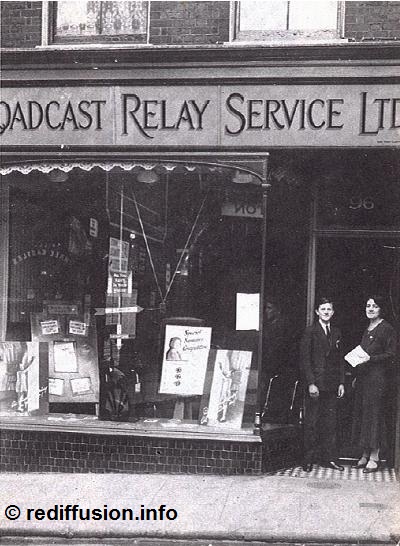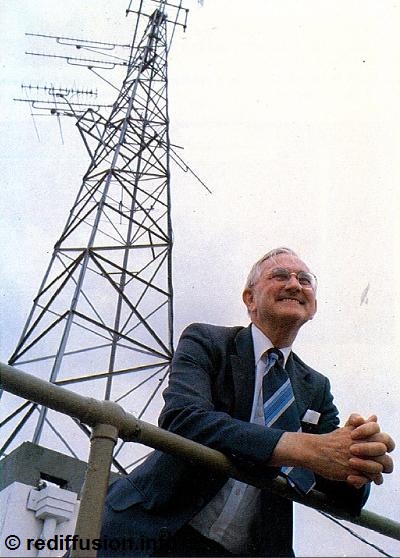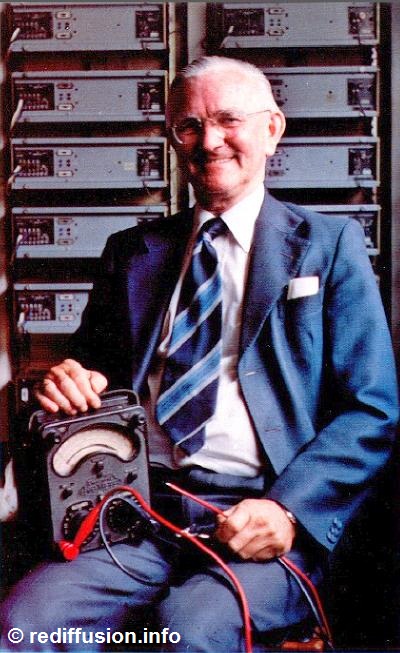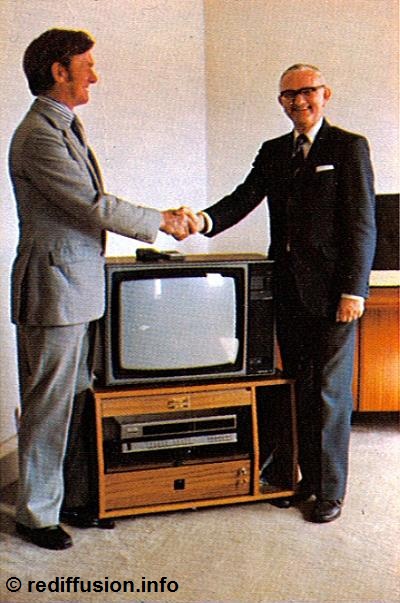
So far as the two policemen were concerned, it was a cut and dried case. They had found Ray Cook on the roof of someone’s house at eleven o’clock at night, equipped with a torch and certain tools.
‘Wired Television?’ Looking for a fault? Did he think they were born yesterday? Throw him in the cells!
Fortunately, Ray Cook was able to persuade them to ring his general manager, Frank Austen, and they released him.
But he recounts the tale of his ‘arrest’ with some relish, for it tells you a lot about the working life he led after the war: the
long, long hours, and the novelty of television then. Ray Cook, senior test engineer in the Southern Region, had worked for
Rediffusion for fifty years, probably the only man yet to do so. Of those years, he regarded the post-war era with the most affection, though he was working at the time about as hard as any man could. "For about twelve months," he recalled, "l worked from nine in the morning till 10,30 at night. We’d work until midnight if necessary"
Ray, who joined what was then Broadcast Relay in 1933, had been seconded in 1945 to work with Ken Easton on the very first experiments with wired television. "We did a lot of the early work here,"
says Ray proudly. "For example, we developed something called ‘tilted wire aerials’, which meant Rediffusion got far better
pictures than anybody else at the time." The main problem was coping with demand for the new service.
"Our first experiment was in Margate. We bought 100 Philips receivers, used four of them for the ‘front end’ and installed
the rest free for subscribers for eighteen months.
"The service opened on Coronation Day in 1953, and we never looked back. We were signing up to 400 subscribers a week."
It was a hard slog, but it was new, and it was unpredictable.
"To start with there was nothing designed, nothing made. We had to do it all ourselves. Mostly we worked by trial and
error, and most of what I know now is learned from experience by trying things out in the field."
‘Wired Television?’ Looking for a fault? Did he think they were born yesterday? Throw him in the cells!
Fortunately, Ray Cook was able to persuade them to ring his general manager, Frank Austen, and they released him.
But he recounts the tale of his ‘arrest’ with some relish, for it tells you a lot about the working life he led after the war: the
long, long hours, and the novelty of television then. Ray Cook, senior test engineer in the Southern Region, had worked for
Rediffusion for fifty years, probably the only man yet to do so. Of those years, he regarded the post-war era with the most affection, though he was working at the time about as hard as any man could. "For about twelve months," he recalled, "l worked from nine in the morning till 10,30 at night. We’d work until midnight if necessary"
Ray, who joined what was then Broadcast Relay in 1933, had been seconded in 1945 to work with Ken Easton on the very first experiments with wired television. "We did a lot of the early work here,"
says Ray proudly. "For example, we developed something called ‘tilted wire aerials’, which meant Rediffusion got far better
pictures than anybody else at the time." The main problem was coping with demand for the new service.
"Our first experiment was in Margate. We bought 100 Philips receivers, used four of them for the ‘front end’ and installed
the rest free for subscribers for eighteen months.
"The service opened on Coronation Day in 1953, and we never looked back. We were signing up to 400 subscribers a week."
It was a hard slog, but it was new, and it was unpredictable.
"To start with there was nothing designed, nothing made. We had to do it all ourselves. Mostly we worked by trial and
error, and most of what I know now is learned from experience by trying things out in the field."
Ray Cook, who joined Rediffusion Thanet branch in the 1933 retires after 50 years service.

REDIFFUSION
Sometimes things did not go as planned. "We were just congratulating ourselves on our success in Margate when a thunder-storm blew out all the inserts in the junction boxes" `
Ray Cook himself had built his first television in his spare time in l938, one of only three existing at the time in Ramsgate.
"I bought all the bits through WireIess World, when I could afford to. The cabinet was four foot by two foot, and had a six inch screen. The first picture I got was Neville Chamberlain, waving his
piece of paper after Munich and declaring ‘peace in our time'."
War came, however, and as well as doing his ordinary work. Ray was monitoring enemy transmissions for the Home Office and helping to install the Air Raid Warning system.
"We were only 25 miles from the French coast, so we were bombed a lot. One night, 4.000 subscribers lost the service after a
raid. But we got most of them back on in a couple of weeks."
Ray Cook's practical gifts showed early. When barely in his teens. he was making radios for friends at school.
But he was candid about why he joined Rediffusion originally.
"Unemployment was as high then as now. You took whatever job you could find! All the same, l was lucky I joined such a good company." 14 years old, he joined Broadcast Relay at a time when it was sending one audio programme down the wire to about 300
subscribers in Ramsgate. "As well as the BBC, we used to relay
Luxembourg and Radio Normandy when we were allowed to. They played dance band music and so forth, that`s why the
service was popular. "I had to sit and fade out one programme and fade in another, using the programme journal which we published
ourselves."
But he thought operating was dull work, and much preferred going out wiring when he got the chance, simple though it was in those days. "Our system was just a pair of open wires and the only faults you got were open circuits and short circuits. Every time there was a gale there were shorts all over the place and I used to be told to go out and help.That was unpaid overtime." Ray also worked seven six hour shifts, for just 7s 6d (37p) a week.
Ray Cook himself had built his first television in his spare time in l938, one of only three existing at the time in Ramsgate.
"I bought all the bits through WireIess World, when I could afford to. The cabinet was four foot by two foot, and had a six inch screen. The first picture I got was Neville Chamberlain, waving his
piece of paper after Munich and declaring ‘peace in our time'."
War came, however, and as well as doing his ordinary work. Ray was monitoring enemy transmissions for the Home Office and helping to install the Air Raid Warning system.
"We were only 25 miles from the French coast, so we were bombed a lot. One night, 4.000 subscribers lost the service after a
raid. But we got most of them back on in a couple of weeks."
Ray Cook's practical gifts showed early. When barely in his teens. he was making radios for friends at school.
But he was candid about why he joined Rediffusion originally.
"Unemployment was as high then as now. You took whatever job you could find! All the same, l was lucky I joined such a good company." 14 years old, he joined Broadcast Relay at a time when it was sending one audio programme down the wire to about 300
subscribers in Ramsgate. "As well as the BBC, we used to relay
Luxembourg and Radio Normandy when we were allowed to. They played dance band music and so forth, that`s why the
service was popular. "I had to sit and fade out one programme and fade in another, using the programme journal which we published
ourselves."
But he thought operating was dull work, and much preferred going out wiring when he got the chance, simple though it was in those days. "Our system was just a pair of open wires and the only faults you got were open circuits and short circuits. Every time there was a gale there were shorts all over the place and I used to be told to go out and help.That was unpaid overtime." Ray also worked seven six hour shifts, for just 7s 6d (37p) a week.
In the fifties and sixties, his main achievement was starting up all the aerial sites in the South East region, eighteen in all.
But he also helped out with the many post war developments which had made the life of Rediffusion engineers tough but never dull.
Ray was considered to be something of a guru at Southern region's Canterbury headquarters. With at vast reservoir of experience to draw on, he was called upon to deal with difficult faults throughout the region.
In 1983, his final year with the company, he was particularly cheered by the more recent developments in cable.
"We worked so hard to develop and install our systems it was heart breaking to see it all beginning to fade away, it's marvellous that at last we can see daylight again."
Ray Cook retired at the end of 1983
But he also helped out with the many post war developments which had made the life of Rediffusion engineers tough but never dull.
Ray was considered to be something of a guru at Southern region's Canterbury headquarters. With at vast reservoir of experience to draw on, he was called upon to deal with difficult faults throughout the region.
In 1983, his final year with the company, he was particularly cheered by the more recent developments in cable.
"We worked so hard to develop and install our systems it was heart breaking to see it all beginning to fade away, it's marvellous that at last we can see daylight again."
Ray Cook retired at the end of 1983
Taken from an article pubished in 1983



